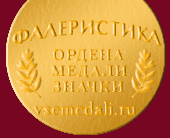Collective military awards
Alongside personal awards - orders and medals - there were also distinctions in the Russian army given to whole military units for gallantry in action. They included silver trumpets and horns, honorary regimental colours, and also special honorary marks of distinction showing that the whole of a military unit displayed bravery in battle.
In 1760, during the war with Prussia, Russian troops entered Berlin for the first time. All the regiments that had taken part in capturing the capital of the Kingdom of Prussia received special silver trumpets with appropriate inscriptions such as, for example, "In token of the victory over the city of Berlin, 28 September, 1760", in commemoration of the occasion.
The first distinction of this kind was awarded back in 1737, more than two decades earlier, when one of the battalions of the Izmailovsky Life Guards Regiment was given silver trumpets for outstanding valour displayed in taking the Turkish fortress Ochakov. At that time, however, the trumpets did not have any honorary inscriptions on them.
Subsequently, following the establishment of the Order of St George, St George's crosses and ribbons began to be attached to honorary silver trumpets so as to emphasise that they were an exclusively military award.
Special honorary banners with inscriptions describing the exploits for which they were given were instituted by Paul I, who conferred them upon the Tavrichesky, Moskovsky, Arkhangelogorodsky and Smolensky regiments in 1800. In the reign of Alexander I, further distinctions were introduced in the design of honorary regimental colours: a representation of the cross of the Order of St George was now fixed to the spearhead of the flagstaff and the tassels were hung on St George's ribbons and not on silver braids. The first St George's banners of this type, bearing the inscription "For the feats of arms performed at Schongraben on November 4, 1805, in a battle fought by a 5,000-strong unit with a 30,000-strong enemy force", were awarded to several regiments that distinguished themselves during the 1805 campaign against the French army.
Infantry units were given honorary banners and cavalry units were presented with honorary standards - the cavalry variety of regimental colours.
Dozens of units of the Russian army won the right to receive this collective award. When a unit which had already been awarded St George's banner performed a fresh feat of arms, an additional inscription with a brief account of the exploit was made on the banner.
Later on, the system of honorary regimental colours was expanded to include so-called jubilee banner ribbons, which had the colours of the ribbons of Russian orders: ribbons "For Meritorious Service" of the colour blue (of the Order of St Andrew the First-Called) for the guards and of the colour red (of the Order of St Alexander Nevsky) for army units.
Honorary colours were also awarded to warships. The first man-of-war to win the right to fly St George's ensign was the battleship Azov, whose crew, fighting under the command of Captain Mikhail Lazarev, distinguished themselves in the sea fight with a TurkoEgyptian squadron in Navarin Bay in 1827. Lieutenant Pavel Nakhimov, Ensign Vladimir Kornilov and Midshipman Vladimir Istomin, who served on the Azov, displayed particular gallantry and military skill in that battle. The Azov was awarded the right to fly St George's ensign "in honour of the praiseworthy deeds of her commanders, the valour and fearlessness of her officers and the bravery of her crewmen." When the Azov fell into disrepair, a new ship named Memory of the Azov was built. St George's ensign was hoisted on the new ship, which emphasised the continuity of combat traditions in the Russian navy. The tradition to give this name to one of the warships has been adopted by the Soviet Navy.
The second ship in the Russian navy to win the right to fly St George's ensign was the 18-gun brig Mercury which, being commanded by Lieutenant-Commander A.I.Kazarsky, fought a battle with two Turkish battleships, the one armed with 110 guns and the other with 74 guns, on May 14, 1829. Despite their tenfold superiority in artillery, the Turks turned out unable to capture the Russian brig. On the contrary, the Russian seamen inflicted heavy damage on the enemy ships by accurate fire and compelled them to withdraw from action. The entire personnel of the Mercury were put forward for decoration (A.I.Kazarsky received the Order of St George 4th Class), and the ship was awarded St George's ensign. It was also decreed that there should always be a ship named Memory of the Mercury in the Black Sea Squadron. Today the Order of the Red Banner Black Sea Fleet includes a ship bearing this name.
There was an instance in the Russian army of presenting a whole regiment with an award that has no parallel in the history of Russia as recognition for gallantry in action. The Pavlovsky Infantry Regiment displayed outstanding fortitude in numerous battles during the 1806 campaign against the French army - those fought at Pultusk, Preussisch-Eylau, Heilsberg and Friedland. All the ranks of the regiment showed bravery in battle. As a mark of esteem for the "remarkable valour, gallantry and fearlessness displayed by the regiment in many battles" it was ordered that "in honour of the regiment all the grenadiers' hats now in its possession remain as they were when the regiment left the battlefield." And the tall grenadiers' hats, pierced with bullets and dented with sabres, remained in the regiment as a monument to the fortitude and bravery of the Russian soldier.
|
ПОИСК:
|
При использовании материалов сайта активная ссылка обязательна:
http://vsemedali.ru/ 'Фалеристика — медали, ордена, знаки славы'
